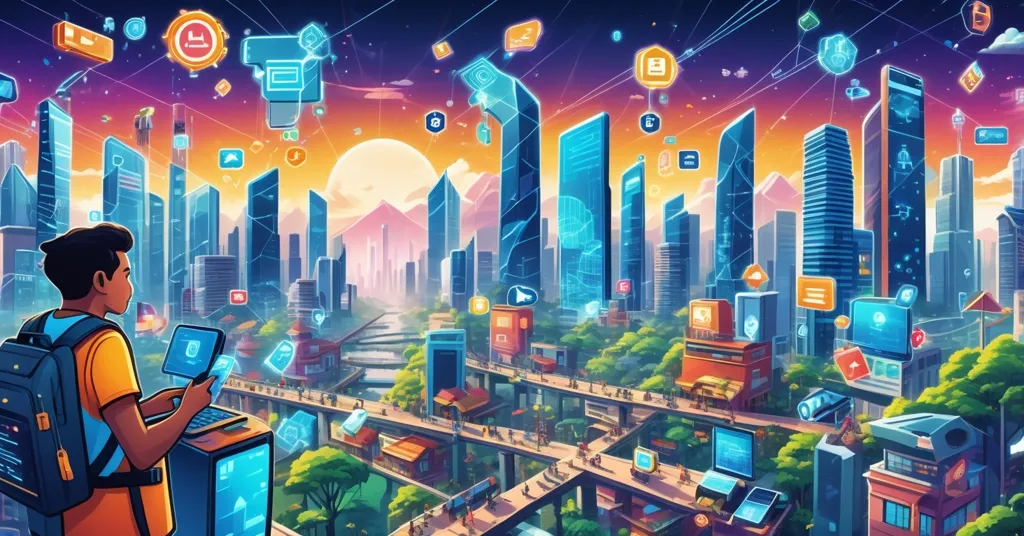Philippines’ Financial Revolution: Fintech and Blockchain Transform Banking at WFIS 2025

Transforming Banking: Fintech and Blockchain Innovations Powering the Philippines’ Financial Future
The Philippines is charging headfirst into a financial revolution, with fintech and blockchain technologies poised to upend traditional banking and empower millions. Day 2 of the World Financial Innovation Series (WFIS) 2025 in Pasay City showcased this seismic shift, spotlighting how digital payments, government mandates, and decentralized solutions like Bitcoin are reshaping money in this emerging market.
- Digital Wave: Post-COVID, digital wallets surge, with 1 in 2 Gen Alphas in Asia Pacific holding financial accounts.
- Government Drive: 89% of Treasury collections are electronic, backed by a presidential push for digital payments.
- Blockchain Edge: Bitcoin and decentralized tech offer low-cost solutions for remittances and financial inclusion.
A Nation Hungry for Financial Change
On September 24, 2025, Pasay City buzzed with urgency as WFIS 2025 convened bankers, innovators, and government officials to tackle the raw challenges facing Philippine finance. This wasn’t just another conference with buzzwords tossed around like confetti—it was a stark reminder of a country where millions remain underbanked, yet the appetite for innovation is insatiable. Since COVID-19 turned the world on its head, digital payments and cross-border transfers have become the go-to for Filipinos. A Mastercard study dropped a bombshell: half of Gen Alpha kids in the Asia Pacific region already manage digital wallets and accounts. That’s not a trend; it’s a full-blown generational pivot, pointing to a future where cash is a relic and banking blends invisibly into daily life.
Imagine a Filipino worker in Dubai sending money home to Cebu, only to lose 10% to predatory remittance fees. That’s the kind of pain point driving this revolution. Technologies like artificial intelligence (AI), cloud computing, and blockchain are tearing down the old, clunky banking systems. AI can tailor services to individual needs, cloud computing lets banks scale without drowning in infrastructure costs, and blockchain—think of it as an unhackable digital ledger—ensures transactions are secure and transparent. But let’s not stop at vague promises. Blockchain, the tech underpinning Bitcoin, could slash remittance costs to under 1% via solutions like the Lightning Network, a layer-2 protocol that speeds up Bitcoin transactions. For a country where overseas Filipino workers (OFWs) sent home $31.4 billion in 2022, per Bangko Sentral ng Pilipinas (BSP) data, that’s a game-changer. For deeper insights into this transformation, explore more on fintech innovations shaping the Philippine financial landscape.
Government Steps Up: Transparency or Control?
The Philippines Bureau of Treasury is dragging public finance into the digital age with a vengeance. Sharon Almanza, a keynote speaker at WFIS, laid out the stakes with brutal clarity.
“The Philippines, like many countries, continues to steer towards an economic landscape that is unpredictable… As we all know, at the turn of this decade, the world faced a generation-defining pandemic. An event that tested not only our health systems, but also the very foundations of global finance.”
Under her leadership, the Bureau reports that as of June 2025, 89% of DIR collections (direct internal revenue streams) and 97% of DOC collections (documentary-related government fees) are processed electronically. This isn’t just about efficiency; it’s a middle finger to corruption, with digital trails making cash mishandling harder. Almanza also highlighted how impact reports for sustainable finance—funding eco-friendly projects with clear accountability—keep investors informed on fund usage.
“Transparency also extends to how we report back to the public. We have this allocation of impact reports; these reports are for our sustainable finance insurance, where we inform investors on how funds are used and how they support our sustainability commitments. This openness is not just about accountability, it is also about building trust.”
President Ferdinand “Bongbong” Marcos Jr. doubled down with Executive Order 170, mandating digital payments for all government transactions across departments and local units. It’s a gutsy move to cut through bureaucratic sludge, but here’s the devil’s advocate take: could this centralization open doors to financial surveillance? When everything’s digital under government oversight, privacy takes a hit. This is where decentralized systems like Bitcoin shine—offering pseudonymous transactions free from prying eyes, assuming you use it right.
Fintech vs. Legacy Banks: Adapt or Die
The numbers don’t lie. The BSP pegs 51.2% of Filipinos with bank accounts, 25.2% of them digital, and 20.1% using digital payments for transactions. That’s a sprint forward, fueled by a young, tech-hungry population. But traditional banks are stuck in a Manila traffic jam of risk aversion and red tape. Sergio Ceniza of Philippine Business Bank didn’t hold back with his warning.
“If the traditional banks do not adjust and keep themselves addressed to these developments, then they will lose their relevance.”
Maria Adelaidee Capistrano of Maya Bank, moderating a panel on future-ready banking, echoed this urgency, pushing for a redesign of trust.
“Banks must rethink trust and redesign systems that will serve everyone.”
Panelists like Catherine Urtola of Bank of China – Manila branch and Amar Laddha of Wolters Kluwer stressed adaptability amid global shifts. Fintech startups are moving faster than a jeepney at rush hour, filling gaps for the underbanked—think rural communities or sari-sari store owners ignored by legacy finance. But let’s not drink the Kool-Aid just yet. Centralized fintech apps like Maya might replace one middleman with another, tracking your every move. Decentralized finance (DeFi) on Ethereum or Bitcoin’s raw peer-to-peer power offers a purer shot at financial freedom, minus the corporate overseer.
Philippines as a Fintech and Crypto Hotbed
Why is the Philippines ground zero for this upheaval? Clifford Barnes of SC Ventures at Standard Chartered nailed the answer.
“The thing I love about emerging markets like the Philippines is they have a need. They have a problem they need to solve… So emerging markets will be at the forefront of innovation because they have the largest need for it.”
He’s spot on. With a massive underbanked population and a tech-savvy youth, the country can leapfrog outdated systems straight to cutting-edge solutions. Platforms like Coins.ph, a local crypto exchange, are already making waves, letting Filipinos buy Bitcoin and altcoins with ease. Reports suggest Coins.ph has over 16 million users, a testament to crypto’s growing footprint here. For OFWs, Bitcoin isn’t just a speculative asset—it’s a lifeline, cutting remittance fees that traditional services bleed dry. But Barnes also threw a cold splash of reality.
“There’s no point in creating something that no one actually needs.”
Translation: hype doesn’t pay the bills. Innovation must solve real pain, not just dazzle with tech jargon.
Blockchain and Crypto: Promise and Peril
Let’s zoom in on blockchain and Bitcoin, the beating heart of decentralized finance. Blockchain’s tamper-proof nature could revolutionize everything from remittances to government transparency. A transaction on the Bitcoin network, verified by miners globally, can’t be fudged—unlike a shady bank ledger. For the underbanked, it means sending or receiving money without needing a bank account, just a smartphone and a wallet app. Ethereum, meanwhile, powers smart contracts—self-executing agreements coded on the blockchain—that could automate loans or insurance for rural Filipinos, no middleman required.
But it’s not all sunshine. Blockchain faces scalability hiccups; Bitcoin’s base layer processes only 7 transactions per second compared to Visa’s thousands. Solutions like Lightning Network help, but adoption isn’t universal yet. Energy concerns around Bitcoin mining also get thrown around—though sustainable mining with renewables is gaining traction globally. Then there’s the regulatory minefield. The BSP has taken steps to license crypto exchanges, but unclear rules could stifle growth or, worse, push it underground. And don’t get me started on scams—fake ICOs and phishing schemes prey on new Filipino crypto users. We’ve got zero tolerance for that garbage. Education and vigilance are non-negotiable if we’re pushing responsible adoption.
The Dark Side of Digital and AI
AI in fintech is another double-edged sword. It personalizes banking—think chatbots that know your spending habits—but are we trading convenience for privacy? Every swipe on a centralized app feeds data to algorithms, and in a worst-case scenario, to overreaching authorities. Bitcoin’s pseudonymous design dodges that trap, letting you transact without handing over your life story. Cloud computing, while cost-effective for banks, also centralizes data, making it a juicy target for hacks. These techs are powerful, but blind trust in them is a rookie mistake.
Collaboration and Regulation: Walking the Tightrope
Fintech startups can’t overhaul finance solo—they need to team up with legacy banks to scale. Think of it as a shotgun marriage: startups bring agility, banks bring reach. But regulators like the BSP must play referee, balancing innovation with consumer protection. Too much red tape kills progress; too little opens the door to fraud. And let’s be real—government digital mandates, while progressive, risk creating a panopticon unless paired with decentralized options. Bitcoin and DeFi aren’t just alternatives; they’re insurance against over-centralization.
The Road to Decentralized Finance in the Philippines
Peering ahead, the Philippines isn’t just riding Asia’s digital wave—it’s steering the ship. With a glaring need for financial inclusion and a population eager to adopt tech, this country could set the pace for decentralized innovation. Effective accelerationism—pushing rapid, disruptive change—fits here like a glove. Bitcoin could become a store of value for the inflation-weary, while Ethereum’s DeFi apps tackle microfinance. But it’s a treacherous path. Banks, startups, and regulators must sync without tripping over egos or outdated mindsets. One thing’s clear: the future of money in the Philippines isn’t waiting for permission—it’s already halfway through the door, and it’s got blockchain stamped on its passport.
Key Questions on Fintech and Crypto in the Philippines
- What’s behind the digital payment boom in the Philippines?
Post-COVID demand for contactless options and a tech-savvy youth drive it, with 50% of Gen Alpha in Asia Pacific using digital wallets, paving the way for crypto uptake. - How is the government boosting financial transparency?
The Bureau of Treasury’s 89% electronic collections and EO 170 for digital payments cut corruption risks, though centralized systems raise privacy concerns solvable by Bitcoin. - Why is the Philippines a hub for blockchain and crypto growth?
Unmet financial needs, a young demographic, and leapfrogging potential make it ideal for blockchain solutions, especially remittances, as WFIS 2025 leaders emphasized. - What happens to banks that ignore fintech and crypto?
They risk obsolescence, losing ground to startups and decentralized networks like Bitcoin if they don’t adopt AI and blockchain, as industry voices warn. - How can Bitcoin and blockchain empower Filipinos?
Bitcoin slashes remittance fees for OFWs, and blockchain secures transparent transactions—vital for including the underbanked in a digital-first economy. - What obstacles does crypto face in this fintech surge?
Regulatory uncertainty, scalability limits, and rampant scams threaten progress, but education and robust policies can cement Bitcoin and DeFi as transformative forces.



